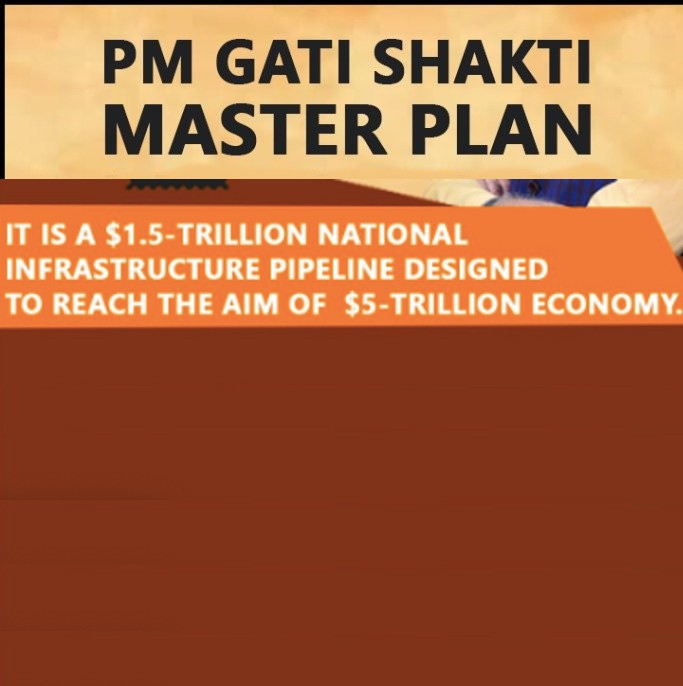PM Gati Shakti, an infrastructure-based development initiative conceived by Prime Minister Narendra Modi-led government, is expected to give an extraordinary impetus in the economic growth journey of India during 21st century.
The programme was announced in October and got another synergy when Finance Minister Nirmala Sitharaman made PM Gati Shakti one of the four pillars of government at the Union Budget 2022/23. The government’s ‘Infrastructure-based development’ initiative PM Gati Shakti will lead to an extraordinary increase in the strength of the economy and hence mandates seamless integration of 16 departments on one platform.
History is replete with instances where countries ushed in a new path of socio-economic development of generations in various countries with infrasttucture focused development initiatives. For example, the New Deal by President Roosevelt in the USA really lifted the country off its feet after the Great Depression. If we look at Japan’s post World War II transit-oriented development was crucial for its growth journey. While South Korea grew at an average rate of 10% per annum between 1960-1990, infrastructure played an important role in the growth of China between 1980-2010 on a similar pace.
The government conceived the project as a digital platform to bring an integrated planning and coordinated implementation of infrastructure projects. The programme envisages multi-model connectivity to provide integrated and seamless connectivity for the movement of people, good and services from one mode of transport to another.
The programme will facilitate the last mile connectivity of infrastructure and also reduce travel time for people. PM Gati Shakti will incorporate the infrastructure schemes of various Ministries and state governments like Bharatmala, Sagarmala, inland waterways, dry/land ports, UDAN etc.
It also includes, economic sones like textile clusters, pharmaceutical clusters, defence corridors, electronic parks, industrial corridors, fishing clusters, agriculture zones that will be covered to improve connectivity and make Indian businesses more competitive. It will also leverage technology extensively including spatial planning tools with ISRO (Indian Space Research Organisation) imagery developed by BiSAG-N (Bhaskaracharya National Institute for Space Applications and Geoinformatics).
Traditionally, there was a lack of coordination between different Departments, for example, once a road was constructed, other agencies dug up the constructed road again for activities like laying of underground cables, gas pipelines etc. This not only caused great inconvenience but was also a wasteful expenditure.
To address this, efforts were made to increase coordination so that all cables, pipelines etc. could be laid simultaneously. Steps have also been taken to address other issues like the time-taking approval process, the multiplicity of regulatory clearances etc.
In the last few years, the government has ensured unprecedented focus on infrastructure through a holistic outlook. This helps to address the past issues through institutionalising holistic planning for stakeholders for major infrastructure projects. Instead of planning & designing separately in silos, the projects will be designed and executed with a common vision.
Prime Minister said the direct capital expenditure of the Government of India in 2013-14 was about Rs 2.5 lakh crore and it got increased to Rs 7.5 lakh crore in the year 2022-23. “Infrastructure Planning, Implementation and Monitoring will get a new direction from PM Gati-Shakti. This will also bring down the time and cost overrun of the projects.
In PM Gati-Shakti National Master Plan, more than 400 data layers are available now; 24 Digital Systems of 6 Ministries are being integrated through ULIP. This will create a National Single Window Logistics Portal which will help in reducing the logistics cost,” said the Prime Minister.
Besides supporting exports and MSMEs globally competitive, PM Gati-Shakti will ensure true public-private partnership in infrastructure creation from infrastructure planning to development and utilisation stage.
Why does infrastructure matter?
In economics parlance, multiplier effects accrue to the economy through infrastructure spending. This means that not only does the project contribute immediately through increased demand for labour, construction materials, but also through the second-order effects improved connectivity brings. Goods & people will move faster between destinations. The cost of logistics comes down.
Studies by the RBI and the National Institute of Public Finance and Policy have estimated the multiplier to be between 2.5-3.5x. This means, for every rupee spent by the government in creating infrastructure, GDP gains worth Rs. 2.5-3.5 accrue.
Furthermore, in times of economic contractions, this multiplier is larger than the one during times of economic expansion. This could imply that public investment if timed and targeted right, can actually ‘crowd-in’ private investment, rather than ‘crowd-out’. To realise these benefits, raising our capital expenditure as a % of GDP will be crucial, at both the Central & State level.
PM Gati-Shakti will bring a new direction in Infrastructure Planning, Implementation and Monitoring so that it will bring down the time and cost overrun of the projects. The programme strengthens the principle of cooperative federalism as the cental government made a provision of Rs 1 lakh crore for the assistance of the states in this year’s budget.
PM Gati Shakti is based on six pillars:
Comprehensiveness: It will include all the existing and planned initiatives of various Ministries and Departments with one centralised portal. Each and every Department will now have visibility of each other’s activities providing critical data while planning & execution of projects in a comprehensive manner.
Prioritisation: Through this, different Departments will be able to prioritize their projects through cross-sectoral interactions.
Optimisation: The National Master Plan will assist different ministries in planning for projects after identification of critical gaps. For the transportation of the goods from one place to another, the plan will help in selecting the most optimum route in terms of time and cost.
Synchronisation: Individual Ministries and Departments often work in silos. There is lack of coordination in planning and implementation of the project resulting in delays. PM Gati Shakti will help in synchronizing the activities of each department, as well as of different layers of governance, in a holistic manner by ensuring coordination of work between them.
Analytical: The plan will provide the entire data at one place with GIS based spatial planning and analytical tools having 200+ layers, enabling better visibility to the executing agency.
Dynamic: All Ministries and Departments will now be able to visualize, review and monitor the progress of cross-sectoral projects, through the GIS platform, as the satellite imagery will give on-ground progress periodically and progress of the projects will be updated on a regular basis on the portal. It will help in identifying the vital interventions for enhancing and updating the master plan.
Narendra Modi suggested that the public-private sector partnership in infrastructure creation via PM Gati Sakti should use all important information regarding the National Master Plan now available on the single platform.
“Due to which it will be possible to get project alignment and various types of clearances at the DPR stage itself. This will also be helpful in reducing your Compliance Burden”, he said. The Prime Minister also asked the state government to make PM Gati-Shakti National Master Plan base for their projects and Economic Zones.
The Logistic Cost in India is considered to be 13% to 14% of GDP. This is more than other countries. PM Gati-Shakti has a huge role in improving infrastructure efficiency. The Prime Minister talked about the Unified Logistics Interface Platform- ULIP provided in this budget and which is being adopted by the various government departments as per their needs, leading to reduced logistics cost.
“24 Digital Systems of 6 Ministries are being integrated through ULIP. This will create a National Single Window Logistics Portal which will help in reducing the logistics cost,” he added.
PM Gati-Shakti heralds a true public-private partnership in infrastructure creation from infrastructure planning to the development and utilisation stage.





